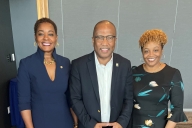You have /5 articles left.
Sign up for a free account or log in.

The announcement of new leadership at the school, college or university level—for example, a new dean, provost or president—can usher in a time of hopeful anticipation about unexplored new opportunities. However, it can also often be an anxiety-ridden period for people who are worried that existing, planned or envisioned programs will be shelved. Before making significant changes, new leaders have an obligation to learn the lay of the land—to spend the time necessary to understand both the programs and the people they are tasked with leading.
But the obligation is not a one-way process. Subordinate leaders within the college or university—such as chairs of departments, divisions or centers—also have an obligation to assist the new leader in understanding the various units within the institution and how they function.
Many management experts would recommend, for instance, that a new dean focus the first year of their tenure on listening to others at the institution to learn about the current state of the school or college. For the new dean to do that successfully, however, chairs and other subordinate leaders must seize opportunities to communicate the specific mission, vision, programs and outcomes of their unit, as well as how those elements impact the various constituencies within that unit. Even though many departments share common names across colleges and universities, the ways both academic and nonacademic programs function can vary greatly. Chairs and other leaders should take the initiative to ensure the new dean is fully informed about their specific institution.
Who should take the lead in setting up these meetings depends to some extent on the campus’s culture. At a large institution, an associate dean might take on the role. In a smaller or more faculty-driven environment, a respected informal faculty leader, such as one of the longer-serving department chairs, could lead the effort. Faculty members who have an established reputation are a better choice than someone who might be viewed as using the opportunity to advance themselves.
As a first step, the chairs should meet formally with the dean and review the overall structure of the college or school and how its various parts work together to serve the students and the wider community. Some of the specific issues they should address in that meeting include the college or school’s mission, vision and programs and how they align and support strategic goals. They should also communicate honestly about any gaps between the vision, mission and goals and what is actually occurring in the departments and at the college, school or broader institution. They should also describe any unexpected challenges or new short-term objectives in process that the dean should be aware of.
Key issues often involve finances, of course. Constricting budgets in higher education are now the norm, so deans are under growing pressure to increase revenue and enrollment as primary objectives. They could be tasked early on in their tenure with eliminating programs and personnel. Thus, the dean and chairs should discuss what the budget expectations should be and how they will be managed. Will chairs oversee departmental budgets, for instance, or will the dean be more involved in budget decisions in order to have greater control over the finances of the entire college or school?
In addition, the leadership team should identify the key informal leaders within the college and broader institution, such as those who can represent support staff or other professionals outside the faculty ranks. Moreover, the team needs to help introduce the dean to key external stakeholders and alumni at the college level, whom they might otherwise be unfamiliar with, in order to build necessary supportive relationships. The chairs should educate the new dean about the accreditation processes for the various programs in the college or school, as well.
Once the dean has received an overview of the college or school as a whole, each department should each meet with the dean separately. Department chairs need to provide a summary of the programming within each of their departments or area. The dean should also meet the various faculty and staff members in context of their programs so as to understand any short-term needs of the department. That can occur at a regular department meeting or a special meeting specifically for this purpose to ensure enough time for an interactive session where both the new dean and the members of the department can ask questions. If the department has regular newsletters or other communications vehicles, the chair should share those with the new leader, as well.
After an initial meeting, the department chairs must continue to communicate with the new dean. They should invite the dean to department meetings and other events so they can better understand and potentially participate in the activities of the department. Such involvement will help the new dean develop a more complete understanding of the organization that they are trusted with leading and will give the faculty, staff and students the opportunity to get to know their new leader.
Clear expectations should be set about how often the dean and chairs will meet as a group and individually. Some deans will want to schedule regular meetings; others might wish to meet only as needed. The campus culture will probably dictate how often meetings are held, but establishing some type of clear communication channel is essential for success, both for the new dean and the chairs. Regardless of the process, the chairs and other subordinate college leaders need to ensure that the new leader and those whom they lead are communicating with each other effectively.
Historically, most higher education institutions left such proactive communication to the dean as the leader. In today’s multifaceted university environment, however, it is the responsibility of all the subordinate leaders to ensure that the new top person is informed about all the key issues, from the very beginning and going forward into the future.
More from Career Advice







.jpg?itok=oxnsN5Wp)
